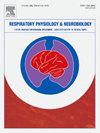The activity of suprahyoid muscles during sevoflurane-induced gasping in mice
IF 1.6
4区 医学
Q3 PHYSIOLOGY
引用次数: 0
Abstract
Sevoflurane-induced gasping in mice involves an enormous increase in inspiratory effort, mandibular movement, and a marked decrease in respiratory frequency (fR). We examined differences in breathing patterns and electromyogram activity (EMGSH) of the suprahyoid muscles (SHMs) during eupnea under 3.2 % (1 MAC: minimum alveolar concentration) sevoflurane inhalation and sevoflurane-induced gasping under 6.5 % (2 MAC) sevoflurane inhalation in eight spontaneously breathing, tracheally intubated, adult mice. We found that the phasic EMGSH is obtained only during inspiration in eupnea and gasping and that integrated EMGSH increases more, as a percent of baseline (% baseline) than tidal volume (VT) during gasping (median [interquartile range]; integrated EMGSH: 720 [425–1965] vs. VT: 300 [238–373], P < 0.05). We also found that the onset of EMGSH precedes the start of airflow while maintaining a bell-shaped EMGSH contour, which characterizes the EMG of upper airway dilator (UAD) muscles during eupnea and gasping. Vigorous respiratory-related mandibular movements were never observed during eupnea but were observed in seven of 8 mice during sevoflurane-induced gasping. Our observations indicate that SHMs act as a preferentially activating UAD muscle, contributing to the development of mandibular respiratory movements.
七氟醚诱导小鼠喘息时耳上肌的活动。
七氟醚诱导的小鼠喘气会导致吸气强度和下颌骨运动的大幅增加,以及呼吸频率(fR)的明显降低。我们研究了 8 只自主呼吸、气管插管的成年小鼠在 3.2%(1 MAC:最小肺泡浓度)七氟烷吸入条件下出现呼吸暂停和 6.5%(2 MAC)七氟烷吸入条件下出现七氟烷诱导的喘息时的呼吸模式和舌骨上肌(SHM)肌电图活动(EMGSH)的差异。我们发现,相位 EMGSH 仅在呼吸暂停和喘气时的吸气过程中获得,在喘气过程中,综合 EMGSH 在基线百分比(% 基线)上的增加幅度大于潮气量(VT)(中位数[四分位数间距];综合 EMGSH:720 [425-1965] vs. VT:300 [238-38] )。VT:300 [238-373],PSH 在气流开始之前,同时保持钟形的 EMGSH 轮廓,这是呼吸暂停和喘息时上气道扩张肌 (UAD) 肌电图的特征。在呼吸暂停过程中从未观察到与呼吸相关的下颌骨剧烈运动,但在七氟醚诱导的喘息过程中,8 只小鼠中有 7 只观察到了下颌骨剧烈运动。我们的观察结果表明,SHMs 是一种优先激活的 UAD 肌肉,有助于下颌呼吸运动的发展。
本文章由计算机程序翻译,如有差异,请以英文原文为准。
求助全文
约1分钟内获得全文
求助全文
来源期刊
CiteScore
4.80
自引率
8.70%
发文量
104
审稿时长
54 days
期刊介绍:
Respiratory Physiology & Neurobiology (RESPNB) publishes original articles and invited reviews concerning physiology and pathophysiology of respiration in its broadest sense.
Although a special focus is on topics in neurobiology, high quality papers in respiratory molecular and cellular biology are also welcome, as are high-quality papers in traditional areas, such as:
-Mechanics of breathing-
Gas exchange and acid-base balance-
Respiration at rest and exercise-
Respiration in unusual conditions, like high or low pressure or changes of temperature, low ambient oxygen-
Embryonic and adult respiration-
Comparative respiratory physiology.
Papers on clinical aspects, original methods, as well as theoretical papers are also considered as long as they foster the understanding of respiratory physiology and pathophysiology.

 求助内容:
求助内容: 应助结果提醒方式:
应助结果提醒方式:


